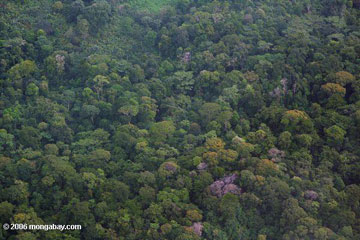Set back for AES on rainforest dam project in Panama
Set back for AES on rainforest dam project in Panama
mongabay.com
June 26, 2007
The World Heritage Committee moved to assess threats to La Amistad International Park, a World Heritage site shared by Panama and Costa Rica, from AES Corporation’s planned construction of four hydroelectric dams on the park’s border. The decision was based on an April 2007 petition from the Center for Biological Diversity and more than 30 other organizations in the United States, Panama, and Costa Rica.
La Amistad is home to more than 215 species of mammals, 600 species of birds, 115 species of fish, and 250 species of reptiles and amphibians, including several hundred plant species and 40 bird species that are found nowhere else in the world. It also supports several indigenous tribal communities that live along its border.
The petition says that the planned dams will be built on two rivers originating inside La Amistad–the Changuinola River and the Bonyic River (a tributary of the Teribe River)–and will flood the rivers with large, standing reservoirs. Indigenous villages as well as upstream fish migration could be impacted by the projects.

Rainforest of La Amistad. Photo by R. Butler
|
“These projects would be detrimental to indigenous cultures which have historically been affected by proposals for supposed âdevelopment,” said Ezequiel Miranda, a community leader living near La Amistad. “In fact, the reservoirs will flood several villages along the Changuinola River, effectively displacing several hundred Ngobe indigenous peoples. And the dams would have massive negative impacts on many diadromous species of fish and shrimp living in the rivers, which migrate between fresh- and saltwater to complete their life cycles. The dams will end this migration.”
Based on these issues and others raised in the petition, the World Heritage Committee expressed concerns over the pending construction of the four hydroelectric dams on La Amistad’s border. The Center for Biological Diversity says that its decision “could encourage the Panamanian government to cancel the dam projects and deal with other threats to the park.”
“The decision adopted by the World Heritage Committee demonstrates a strong commitment to the conservation of World Heritage sites,” said Peter Galvin, conservation director with the Center for Biological Diversity. “We hope this sets a precedent for protecting sites under threat from hydroelectric dam construction.”
Linda Barrera, a Panamanian citizen and law clerk for the International Environmental Law Project, which authored the Petition, said: “This is a positive step in the right direction because it encourages community groups supporting this petition that their efforts were not in vain. Somebody was listening, and hopefully it will lead Panama to reevaluate its policies and decision relating to better conservation for La Amistad.”
Still the Center for Biological Diversity cautions that La Amistad is not out of the woods yet, with dam construction is still pending.
Related
Panama Canal port projects threaten mangroves. Port development and land speculation in Panama is turning some of the Caribbean’s most productive mangrove forests into landfill. The landfill would be used for container storage near the city of Colon, at the mouth of the Panama Canal. But local scientists say the transformation could have unintended environmental consequences.
AES Corp seeks to flood rainforest World Heritage site. American power company AES Corporation seeks to flood sections of Panama’s La Amistad World Heritage site, alleges a coalition of more than 30 environmental groups that today filed a petition against the electric utility.














